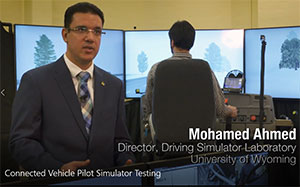
A University of Wyoming College of Engineering and Applied Science faculty member’s work to improve safety on Interstate 80 and other routes has been recognized by the Transportation Research Board of the National Academies of Sciences, Engineering and Medicine.
Mohamed Ahmed, UW’s Williams and Person Professor in the Department of Civil and Architectural Engineering, along with co-author Omar Raddaoui, received the Transportation Research Board Truck and Bus Safety Committee’s Deborah Freund Paper Award for their study, “Evaluating the Effects of Connected Vehicle Weather and Work Zone Warnings on Truck Drivers’ Workload and Distraction Using Eye Glance Behavior.”
“Dr. Ahmed and his team are conducting leading-edge research that directly benefits the state of Wyoming and its citizens. It is a well-deserved award. This is a great example of UW’s commitment to the land-grant mission, and it demonstrates how civil engineers help solve real-world problems and improve the quality of life for people,” says Tony Denzer, head of the Department of Civil and Architectural Engineering. “As we all know, highway travel in Wyoming can be dangerous, and I believe Dr. Ahmed and his team are making a real contribution to safety. It’s rewarding to see that work validated and honored at a national level.”
“We are very grateful and humbled to start 2021 with such great news,” Ahmed says. “This has been a tough year for everyone, and it is such an honor to see our hard work is paying off.”
For the winning study, Ahmed and Raddaoui sought to analyze the workload demands and distraction introduced by spot weather impact warning (SWIW) and work zone warning (WZW) applications -- features of new “connected vehicle” technology that allows vehicles to communicate with one another and transportation agencies, providing real-time information regarding weather, road conditions and hazards -- on professional truck drivers.
Ahmed operates the WyoSafe Simulation and Human Factors Center for Connected and Automated Vehicles, which includes state-of-the-art driving simulator technology. The center has been working on various traffic safety topics to assist the Wyoming Department of Transportation (WYDOT) and other transportation agencies in their mission of improving safety and operations of roadways, especially for heavy commercial vehicles.
According to the study, driving is primarily a visual task. At least 90 percent of the information consumed as part of the driving task is the product of the streaming of visual information, such as vehicle speed, road geometry, position relative to lane markings, brake lights of nearby vehicles, headway distance and traffic signs, among myriad other elements.
“The traffic environment, by its very nature, is a dynamic and continually evolving visual-cognitive construct,” Ahmed says. “As a result, the safe navigation of the traffic environment necessitates continual driver attention to operate the vehicle and scan the roadway for potential hazards.”
Using driving simulator experimentation and eye-tracking technology, the researchers determined that weather notifications did not invoke any notable workload or distraction to the participants. Conversely, the WZWs deteriorated the participants’ roadway scanning behavior and brought about prolonged off-road glances and, therefore, could carry adverse safety impacts to drivers in real-life conditions.
“This was largely attributed to the fact that, unlike the weather notifications, the WZW application appeared to have overcommunicated information to the participants during a short-time window and under difficult driving conditions,” Ahmed says.
In light of these findings, WYDOT, the leading stakeholder in the study, is reevaluating and amending the design of the WZW application so that message flow rate is reduced, and only necessary information is displayed to minimize the distraction introduced from the application.
Ahmed credits his team members, including Sherif Gaweesh, deputy manager of the WyoSafe Simulation and Human Factors Center for Connected and Automated Vehicles, for their work and assistance in various driving simulator studies.
The paper was presented at the Transportation Research Board annual meeting, an international conference in the transportation engineering field, in Washington, D.C., last year. Shortly after, the paper was published in the Transportation Research Record (TRR).
“The TRR has long been recognized as one of the preeminent, peer-reviewed publications for transportation research papers in the United States and around the world,” Ahmed says. “This recognition means a lot in our research community due to its great competitiveness and overall impact on people’s lives.”
Ahmed and Raddaoui received the award virtually at the 2021 Transportation Research Board annual meeting Jan. 12.
To learn more about Ahmed’s research, visit his UW faculty webpage or email mahmed@uwyo.edu.
To view a video of one of the driving simulator studies, go to www.youtube.com/watch?v=JLaS-s1OvCI.

